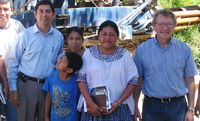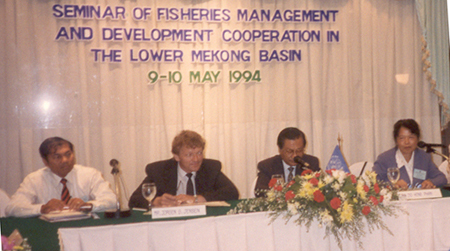Regional fisheries cooperation in the
Lower Mekong Basin: how did it start?
By Jorgen G. Jensen *
Recycling the 'Mekong spirit' in Central America
After leaving MRC Fisheries Programme in July 2001, Jorgen Jensen spent four years at the headquarters of Danida in Copenhagen, ultimately as Chief Advisor of the Agriculture, Forestry and Fisheries Section of Technical Advisory Services. In 2006, he moved to a field job in Guatemala as regional programme advisor coordinating the Danida-supported Regional Environment Programme in Central America, known as PREMACA in Spanish. The programme includes all seven Central American countries but mainly works with Guatemala, Honduras, El Salvador, Nicaragua and Costa Rica.
"The big issues here are the management of water resources, how to cope with increasing loads of garbage threatening the environment, how to develop a business sector based on a sustainable use of natural resources and how to include the indigenous Maya population in this development," he says. "The similarities between regional cooperation in Central America and the Mekong are many, and a lot of experience from Mekong is being recycled here, for instance the creation of an active regional coordination body similar to the TAB."

Mr Jensen (right) in Guatemala
As part of an occasional new series, the founding manager of the Mekong Fisheries Programme recalls the early days of regional fisheries cooperation and how the programme evolved after the Mekong River Commission was established in 1995.
In 1992, the secretariat of the Interim Mekong Committee in Bangkok contacted the Danish Embassy and asked for Danida support for fisheries development in the Mekong Basin. The reaction was positive and planning for the first three projects started immediately. In July 1993, I was assigned as senior programme officer for fisheries at the Mekong Secretariat in Bangkok where I was in charge of the first project, Institutional Support to Mekong Fisheries, and preparing for the next two projects, Management of Cambodian Capture Fisheries and Management of Mekong Reservoir Fisheries. In May 1994, we held our first "annual meeting" at the Hotel Princess in Bangkok where representatives of the four riparian countries agreed to the main principles of a Fisheries Programme for which I served as programme manager until returning to Danida in Copenhagen in July 2001.
Plenty of challenges—and scope for
solutions
There were lots of challenges from the beginning. First of all,
a general opinion reigned that the fish resources of the Mekong
Basin were declining steadily year by year. For the whole basin,
officially-registered fish production added up to only 356,000
tonnes per year. Although there was no regular comprehensive
data collection, the figure tended to be adjusted downwards
annually, fuelling an impression that the resources could not
be rescued and that it was hardly worth trying. But in the case
of fish production from the Tonle Sap Lake in Cambodia, this
was clearly not true. Taking a closer look at the data, it appeared
that official statistics in Thailand were based exclusively
on the registered catch from big reservoirs while statistics
in Cambodia were based on historical catch estimates from the
1950s which were widely cited but never verified. Establishing
a solid database and calculating the real value of annual fish
production became one of the programme's first priorities.
Another challenge was the lack of cooperation between the line agencies for fisheries in the four riparian countries. The agencies did not know each other and the first approaches towards cooperation seemed to reflect some degree of cautiousness. Hence, getting people together to talk about common problems and opportunities became another priority of the programme.
A dam on the Tonle Sap?
To improve cooperation, our first coup was to assign Sam Nuov
as the first riparian fisheries officer in early 1994. As a
Cambodian who had studied in Viet Nam and Thailand, he was able
to speak all four riparian languages and English. We then started
the Cambodian Capture Fisheries Project under the guidance of
Niek van Zalinge and Mahfuz Ahmed and began collecting and analysing
data. We initially thought that all plans for large dams—for
which the Mekong Committee had originally been established in
1957—had already been dropped due to the huge negative
side effects. But the wake-up call came when the Canadian team
leader of a hydropower planning mission suddenly appeared. As
one of 12 possible run-of-river hydropower dams on the mainstream,
the Canadian asked what I thought about "a long, low, sling
dam across the outflow from the Tonle Sap." The idea underscored
the need to get to know the value of the resources and the impact
of such projects.
Results come slowly ... but they come
With the basin's total fish catch today estimated at more than
two million tonnes with a first-sale value in the order of $2
billion, it may now seem strange that the programme's first
real ground-breaking achievement was a much more cautious estimate.
After much calculation, estimation and discussion, we published
a front page article in Catch and Culture
in August, 1996 (the newsletter was launched in 1995, the same
year that the Mekong River Commission was founded, superseding
the Interim Mekong Committee). The headline read "1,000,000
tonnes of fish in the Mekong?" and argued that new
data accumulated by the programme pointed in that direction.
This was maybe the first big eye-opener regarding the importance
of Mekong fisheries resources. Within months, it was being cited
in World Bank technical papers and the fisheries sector started
to be included among the important economic sectors of the region
whose development had to be taken into account.

Mr Jensen (second from left) at the
first 'annual meeting' in Bangkok. The meeting
brought together Cambodian, Lao, Thai and Vietnamese fisheries
officials for the
first time and pre-dated the Mekong Agreement by almost a year.
The other important development was the establishment of the Technical Advisory Body for Fisheries Management. The TAB was conceived on a boat in the middle of the Nam Ngum Reservoir in Lao PDR in early 1998 during the first visit by senior fisheries officers from the four riparian countries to important fisheries sites in the basin. The Chief Executive Officer of the MRC and the annual meeting of the programme approved the TAB terms of reference in 1999. The new body gave national line agencies and the National Mekong Committees a central role in coordinating the management of the basin's fish resources and combining national capacities for such purposes. It also made the programme more sustainable in the event of donor withdrawal.
New and old challenges
New challenges are coming up all the time and some old ones
require new answers. It seems that one of the most important
challenges remains the need to strike a balance between maintaining
fisheries resources as a vital source of food and income for
the people of the basin and harnessing the potential for hydropower
development. The issue is well presented in the December 2008
issue of Catch and Culture. Mr Jensen
on a field visit in the early days of the programme. When the
costs of negative side effects are taken into account, too many
hydropower and other large-scale development projects have turned
out as net losses to national or regional economies. Losses
are frequently shouldered by the part of the population which
benefits least from such investments.

Mr Jensen on a field visit in the
early days of the programme.
For such reasons, it is very important for the Fisheries Programme and riparian institutions to continue their efforts to describe key fish habitats and migration routes and to get the size and the value of the resources right, giving governments an important decision-making tool for economic development in the basin. One of the most decisive factors in the economics of hydropower is the height of the "head" or vertical distance which may be utilised for power production. High heads are usually much easier to obtain in smaller tributaries rather than the slower flowing mainstream of a river or the lower parts of main tributaries. Still, some high reaches of tributaries may have unique faunas or roles in fish production which should be thoroughly investigated in advance of a decision. The Fisheries Programme and the Technical Advisory Body have a very important role to play in this context.
* Mr Jensen is based in Guatemala as regional programme advisor to PREMACA, the Danida-supported Regional Environment Programme in Central America
Choose a newsletter: